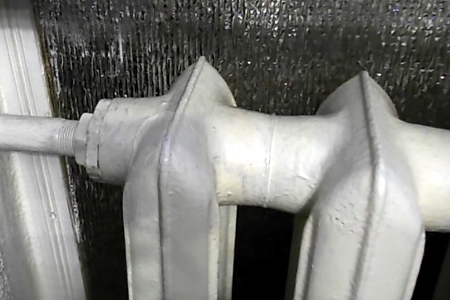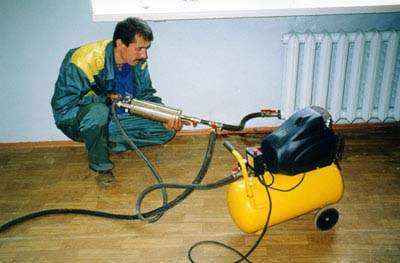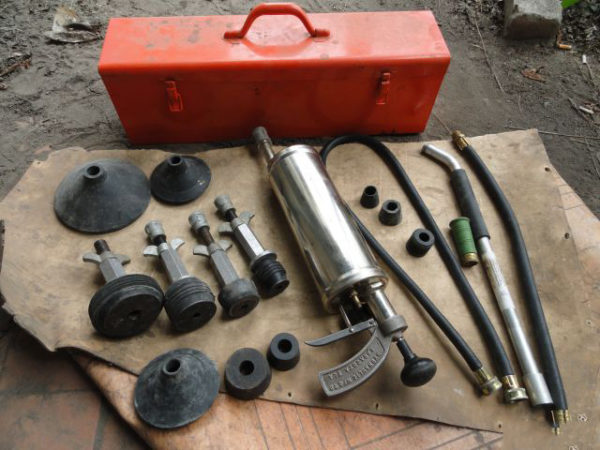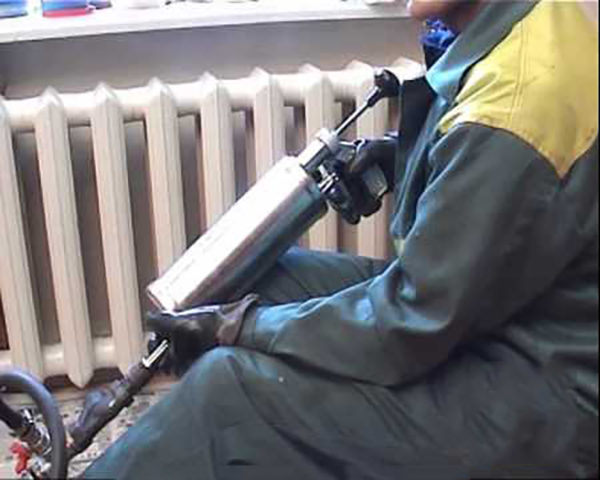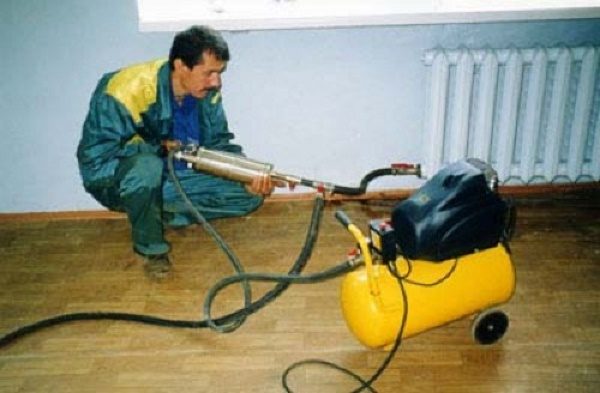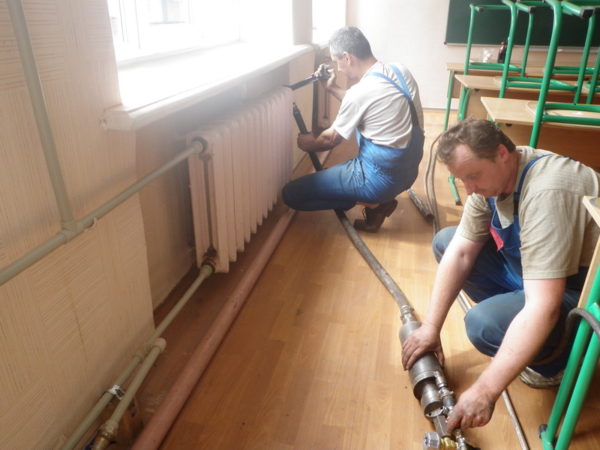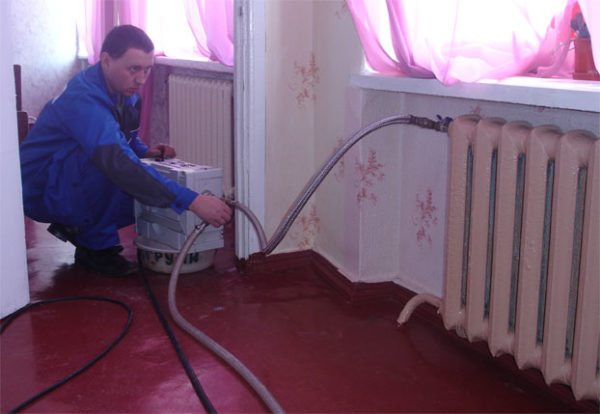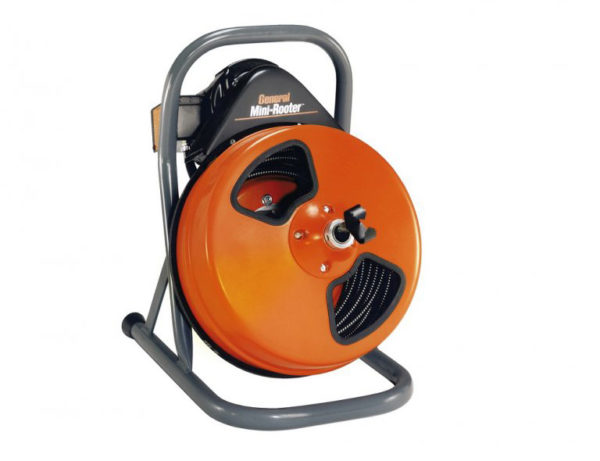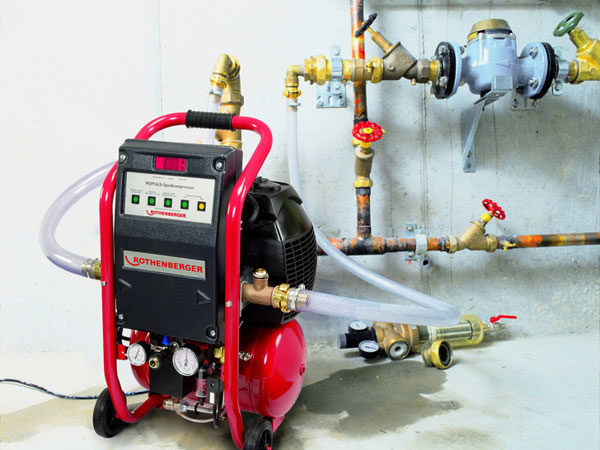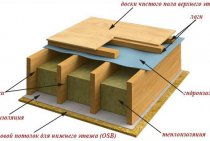How to disassemble a cast iron radiator
The joints of the old battery are strong enough. In many cases, they “grow together” so much that one force is not enough. Therefore, before disassembling the battery, it should be placed on the boards and prepared properly.
The simplest preparation involves heating the joint. To do this, use a building hair dryer or a blowtorch. The latter is able to burn old paint. However, this is not scary.
More serious preparation involves heating the metal to such an extent that it begins to glow. After that, they try to unscrew the nipple. This can be done both when the alloy becomes very hot, and when it has cooled noticeably. The second option is even better, because during cooling, the gasket becomes cracked and the strength of the connection becomes weak. It is often shown in videos.
To disassemble a battery made of cast iron, follow these steps:
- Unscrew the plugs (plugs).
- Attach a radiator key to the device from above so that the flattened end falls on the nipple. On the key, in the place where the battery ends, make a mark using chalk or electrical tape.
- Insert the key into the bottom hole.
- Twisting it along the axis to the right and left, insert it into the product to the drawn mark.
- Determine in which direction the nipple is twisted. To do this, bait it with the right and left sides. If you managed to bait it with the right side, then you need to unscrew it counterclockwise.
- If it was possible to move the nipple, then make one turn. Further, a similar procedure is done with the nipple at the other end of the section.
- Both nipple-nuts are unscrewed in turn. Otherwise the section will crack.
- Similarly, you need to unscrew all sections.
If it was not possible to disassemble the heating battery in this way, you will have to cut the section that is leaking. At the same time, they saw it in the center of the nipple. The work is done by picking up a grinder or a hacksaw.
Another option is to smash the bad section with a sledgehammer. You need to break the middle part of the section. The nipple, which remained intact, is unscrewed using a plumbing wrench. It can also be knocked out with a hammer and chisel. After that, you need to clean the threads in entire sections.
Tools for disassembling a cast iron device
Their list consists of:
- Radiator key.
- Chisels.
- Hammer.
- Small sledgehammer.
- Brushes with metal bristles.
- Blowtorch.
- Plumbing key No. 2.3. They need to unscrew the side plugs or plugs.
In many cases, there is no radiator key. The situation is complicated by the fact that it is almost impossible to find it in hardware stores. In the markets, of course, it is. Also, plumbers must have such a key.
The key itself is a round metal bar. which is 18 mm in diameter. One of its ends is flattened and resembles a spatula. It has dimensions of 28x40 mm. Thickness 6 mm. At the other end is a welded ring. You need to insert a lever into it. As for the length of the key, it should exceed half the length of the radiator by 30 cm.
You also need to prepare a few boards. Chocks may come up instead. They will put the battery before disassembly.
How to rinse cast iron radiators
The efficiency of cast-iron radiators, the decrease in their heat transfer depends on many factors, including the cleanliness of the internal cavities. The high temperature of the coolant contributes to the accumulation of scale on the walls of the sections. From periodic draining and filling, radiators can dry out, which leads to corrosion.Particles of scale, rust, and other mechanical impurities that get inside due to poor water filtration mix with the coolant and clog batteries and pipes. As a result, the quality of heating decreases, fuel consumption increases.
It helps to cope with such a problem by periodically washing cast-iron batteries with your own hands. This work can really be done independently, without resorting to the help of any firms. To perform cleaning, you should prepare and follow the sequence.
Signs by which you can understand that it is necessary to clean the heating devices:
- Uneven heating of the radiator. At normal pressure and temperature in the network, without airing, the top of the battery is hot and the bottom is cold. Or vice versa. And also with hot supply pipes - the radiators are barely warm.
- The heating system takes longer to warm up than usual.
- A clear symptom of the presence of large contaminants in the battery is an increase in energy consumption.
Flushing heating systems in a private house
In private houses, especially those located outside the city, the problem of cleaning the heating system is more acute. This is due to the fact that the water circulating in the system is taken from wells and reservoirs where it is not purified. Thus, much more sludge and other fine fractions that pollute the pipeline accumulate in heating radiators. In this case, it is much more expedient to clean the entire heating system, rather than individual radiators.
Flushing of cast-iron pipelines is carried out in the summer, but not in the heating season! Before cleaning, all valves must be opened to bleed air from the batteries. This procedure is best done by a practicing master plumber. This work requires accuracy so that a flood does not occur and the equipment does not deteriorate.
It is not necessary to let water out of the boiler, the steam line is closed for the duration of cleaning. When the air is released and the corresponding valves are closed, then water is let through the entire heating system. Water must be supplied until clear water flows from the heating pipes.
For better cleaning, cleaning agents can be added to pipelines: soda ash, whey, vinegar. You can use chemical compounds: a means for washing car radiators or concentrated alkali "Mole".
After using chemical compounds, the pipelines must be thoroughly flushed. To do this, the boiler is heated and hot water is passed through the system, which will wash away rust residues, oil contamination and cleaning agent residues.
The procedure for flushing the system must be carried out 1-3 times a year. This will depend on the purity of the water supplied to the pipelines.
It is important to note that after the heating season it is not necessary to release water from the system. This is due to the fact that empty radiators are more susceptible to corrosion than those filled with water.
During the summer period, the water in the pipes also rusts, and therefore, before the next heating season, it is imperative to drain the rusty water and flush the system with the addition of bleach.
When to Clean Radiators
The main indicator of the level of comfort is the temperature in the room. According to the established norms, its minimum indicator for apartments and residential buildings is 18 ° C, however, many begin to feel comfortable only when this indicator reaches 21 ° C, and maybe even higher. What to do if the temperature in the apartment is below the established norms, and representatives of public utilities claim that they supply heat in full. Most likely, this is the case, it’s just that the radiators are clogged in your apartment - a problem that you have to meet quite often. The following factors indicate that your radiators require flushing:
- when trying a heating riser, you suddenly find that its temperature is much higher than the temperature of the heating radiators;
- in one room, the radiators work with maximum efficiency, and in the other they are barely warm or do not heat at all;
- it is warm in the apartment of your neighbors in the riser, and you do not stop complaining about the quality of heating in your apartment;
- the heating radiator in its upper part is slightly warm, and its bottom is cold;
- sections of radiators are heated differently.
If at least one of these symptoms is detected, then it is necessary to start "treatment" of your radiators.
This can be done in many ways, but it is necessary to do this, since you still have to pay for heating. And for what to pay, you ask yourself a completely logical question. Thus, without delay, the problem must be solved. If you still do not know how to flush a heating radiator, we recommend that you talk to experts, or read this manual carefully.
Pneumopulse cleaning of the radiator
We disassemble and clean the cast-iron battery
A cast-iron radiator is such a heating device that, over time, may lose its thermal power due to dirt that has sailed along with the coolant and remained inside the sections. In addition, gaskets can be destroyed in it. And this turns into the destruction of the paint layer and the flow of the heating device.
In the first case, it is enough to remove the radiator and clean or rinse it. In another, besides cleaning, it still needs to be disassembled. If the heating battery is relatively new, then it should not be difficult to disassemble it. However, if there is a device in the house with an “age” of 40 years or more, then its disassembly will be accompanied by problems. After all, for a long time:
- The joints of the sections "grow together".
- The internal protrusions of the nipple are corroded by the coolant.
True, the situation is somewhat facilitated by the fact that once upon a time, tow with paint was wound on the nipple for a better connection. Due to this, the tow does not allow the section to grow together with the nipple. A rubber gasket was always placed on the joint formed by the sections. In many cases, it is its drying and cracking, as well as subsequent destruction, that causes water to leak, which worsens the appearance of the paint.
Cleaning batteries with special equipment
Cleaning cast-iron batteries without removing them from their place can be carried out using special equipment. The following complex equipment is designed for domestic needs:
- pneumatic gun "Typhoon";
- device for electrohydropulse impact ZEVS-24;
- apparatus for cleaning Mole-Mini.
Pneumatic pistol "Typhoon"
Flushing the battery with a Typhoon air gun
The equipment is compact and easy to handle. It is used to perform a point impact on blockages in water and sewer pipes with a diameter of up to 150 mm. The essence of the process is a hydraulic ram to remove hardened deposits from the walls of the equipment and adjacent risers with a shock wave at a speed of 1.5 km / h, which extends to a distance of 60 meters.
Pneumatic gun "Typhoon" in operation
Such cleaning of the heating system allows you to cleanly remove contaminants that are not amenable to conventional hydraulic flushing.
"Typhoon" is indispensable as a plumber's tool for cleaning blockages in various hard-to-reach places. Depending on the configuration and weight, the device has 6 modifications and the following indicators:
- cleaning inner diameter up to 150 mm;
- the maximum firing range to the object of influence is 60 m;
- special valve design for kinetic ramming;
- manometer on the body;
- Possibility of manual loading.
Complex flushing of heating batteries
As a rule, "Typhoon" is used in combination with an automatic installation ZEUS-24 and a device for cleaning hard-to-reach objects Krot-Mini.
Installation ZEUS-24
ZEUS-24 has small dimensions and sufficient power to destroy hardened heating devices, internal and external water supply and sewerage networks that have firmly adhered to the inner walls. The essence of its work is based on electrohydropulse impact on solid pollution in pipes with a diameter of 7 to 150 mm. The electric discharge created by the device leads to the appearance of a shock wave and powerful hydrodynamic flows that act on hardened blockages, scale and deposits.
The procedure for hydropneumatic flushing of heating radiators (batteries)
- destruction of blockages of any strength;
- safety of the cleaned equipment;
- cleaning of hard-to-reach bent and spiral pipes;
- wear resistance of manufacturing materials;
- safety switch on the plug.
Apparatus Krot-Mini
The device has the following advantages:
- the ability to work with various drums and spirals with a diameter of 6 to 13 mm;
- easy procedure for replacing the drum;
- to facilitate work, the distribution pipe is located inside the drum;
- automatic feed of the spiral;
- strong and flexible helix of hardened steel cable wrapped with hardened steel wire;
- high torque allows you to remove persistent dirt;
- standard equipment consists of 4 different nozzles that allow you to perform a complete cleaning of pipes and removal of foreign objects;
- for use in wet rooms, the device is equipped with an RCD.
Flushing radiators with the Krot-Mini device
How to provide warmth and comfort in your home depends on the choice and preferences of everyone. You can extend the life of old equipment or replace it with a new, more modern one.
How to wash cast iron radiators and chemistry will help us again
What is the cause of battery contamination? The quality of water for some time leads to the fact that many mechanical particles settle in heating systems. A very small wire and so on simultaneously with water moves along the heating risers. In the non-heating season, water is usually drained. This leads to the fact that pockets of rust appear in the pipes.
The supply of hot water under pressure exfoliates rust particles, and they also settle on the batteries. And the water itself, which is allowed into the heating system, is very often not considered clean. This accumulation of very different debris in cast iron heating systems leads to the fact that for years they eat up the rust waste circulating through the system and the battery becomes clogged.
For some time, this is reflected in the quality of heating. Even with very good heating of cast-iron pipes, they are possible only warm or slightly warm, although the riser itself is hot. If this happens, this is a sure sign that the heating system is clogged and should be cleaned out.
do-it-yourself cleaning cleaning washing cast iron batteries.radiators
Since this difficulty does not bypass any person, consider how to clean cast iron radiators
If you do not take into account the weight of the object, the work of cleaning is far from heavy. There are several options for how you can clean heating systems.
From the following, you can choose your ideal option.
You can clean the battery from debris using soda ash, car heater flushing agents, whey, vinegar essence, and many other options.
Cleaning cast iron batteries begins with their dismantling. However, if they do not have many layers of paint, they can be disassembled into more very small parts to make it easier to handle. This procedure should be done in the season when the apartment is not heated.
One option is that ordinary soda ash is poured into hot water and poured into the heating system. In this case, plugs should be installed at both ends of the heating system.The battery can be shaken up and after a short time, approximately one hour, knock on the perimeter with a wooden hammer so that the corrosion adhering to the walls is separated.
Then we open one plug and bring the hose, previously combined with the water meter assembly. Open the second plug and open the tap. We immediately make a big pressure so that under pressure more rust comes out of the battery. If you have an air blower at your disposal, you can use it to create more pressure.
Flushing of cast iron batteries can be done with a product prepared for flushing a car heater. Before pouring the product into the heating system, read the dosage for a specific volume on the instructions and follow it.
So, the agent is poured in and hot water is added, but the battery is not completely filled. For 2 hours, parts of the battery must be moved at intervals of 10 minutes. At the end of this time, the heater is washed with water with strong pressure and in a small amount so that no corrosive particles remain.
And how to clean a cast-iron battery with whey? The whey is poured into the battery, and, as with soda ash cleaning, the heating system is tapped and turned over to shake the whey. The acid in the whey will eat away the rust and clean it out of your heating system.
In order to subsequently reduce the amount of rust on the batteries, you can remove the small tip of the pipe with a plug in front of the inlet and attach magnets to it. The magnet will attract rust, and it remains only to occasionally open the plug at the end of the pipe to remove corrosive particles.
Signs of contamination of a cast iron battery
Since after the end of the heating season, the water is drained from the system, and it stays dry all summer, this causes corrosion even in the most resistant metal. For many years, small rust formations do not harm the heating system and its elements, but over time, rust layers become thicker, changing the quality and efficiency of radiators.
You can notice that flushing of cast-iron batteries is required by several signs:
- If during the heating season it is found that one of the sections or the entire radiator is colder than the rest of the devices, then this is a clear sign that the channels in it are clogged or narrowed by rust.
- When the temperature of the riser exceeds the heating of the battery, this is another sign that the hot is not fully supplied to it.
- In the event that the batteries are slightly warm in the entire apartment, you should not immediately scold the "negligent" workers of the heating network. You need to find out from your neighbors how hot their batteries are. If it is warm in their apartment, then you should think about how to rinse the cast-iron batteries under the conditions of the heating network.
- Another clear sign of clogging can be uneven heating of the battery. If this is not an airlock, which is easy to check by opening the Mayevsky tap, then it is scale or debris.
- It happens that in one radiator one section is colder than the other. This means that the channel in this place is clogged. Since it is impossible to flush cast-iron radiators in individual sections, the entire structure will have to be dismantled.
These are the main signs that batteries need to be cleaned. In order not to bring things to such extremes, it is better to carry out preventive flushing of heaters, although sometimes you can entrust this process to heating network workers before the start of a new heating season.
Washing with soda ash and serum
According to a video shot by various experts, cleaning with soda ash is carried out as follows:
- Plugs (plugs) are placed on two holes of the extreme section.
- Soda ash is diluted in hot water. Half a standard pack is enough for 6-10 liters.
- Raise the heating battery from the floor, placing it on the section with plugs.The section with two free holes should be at the top.
- Water with soda ash is poured through one hole. Air will come out through the other. Therefore, it does not need to be silenced.
- Plug both holes and put the battery on the floor. The heating device must lie down.
- So that the soda ash can eat off the stuck dirt, rust, and possibly even the old paint that got in with the water, the radiator needs to be shaken. To do this, they take the top and raise / lower it several times. The bottom should not come off the floor. The same is repeated on the other side.
- They rest for 1 hour, watching a video on the Internet about the features of removing old paint from cast iron and applying a new one.
- Lightly tap around the entire perimeter with a wooden mallet. This is done so that the dirt finally lags behind the walls. At this time, the paint may lag behind. This means that it did not attach well to the cast iron.
- They put the heating battery on the bedside table so that one of the plugs is in the air.
- Substitute a bucket under the plug and unscrew the plug.
- After draining the water, the radiator should be flushed. To do this, unscrew the plug at the opposite end and insert the hose from the water supply. Open the faucet. Water will flow into the radiator under pressure, thanks to which it will be possible to wash off the dirt and clean the heating device to the end.
To clean the radiator with serum, you need to perform all the above steps. Just use whey instead of soda. This process, of course, can be seen in different videos.
How to flush a heating radiator at home
It must be emphasized that the batteries should be cleaned at the end of the heating season.
Scheme of chemical flushing of the heating system.
In order to wash the heating battery alone, you need to drain the water from the heating system and dismantle the radiator. Washing is carried out with mixtures of caustic soda, acetic acid, whey, as well as with the help of household chemicals.
Cleaning the radiator is done at home in the bathroom. In order not to destroy the enamel of the bathtub, dense rags are lined on its bottom, and a mesh is placed in the drain hole so that large contaminants do not seep into the gutter.
Flushing the cooling system on a Prior car. Dude mixed 2 antifreezes, ended up with an "explosive mixture" ...
All plugs must be removed from metal batteries, and hot water should be poured into open holes. After the first filling, the radiator must be shaken and drained of water with debris particles. Pour water a second time, but with the addition of a cleaning agent: soda ash or caustic soda, whey, vinegar. Acetic essence with a concentration of 70% use the entire bottle for one radiator.
After pouring this solution, the plugs should be closed and the device left for at least 1 hour. After the time has elapsed, the battery must be shaken well, tapped on it with a wooden hammer so that the remnants of rust and plaque are separated from its inner surface. The solution is drained and refilled with clean water. Flushing with water is carried out so many times until clean water flows out of the battery.
Thoroughly flushing the radiator cavity is also important because lactic or acetic acid residues can provoke rust formation.
Radiator cleaning scheme.
As a cleaning agent for a heater, you can use a car radiator cleaner. To do this, pour hot water into the cast-iron cavity with the addition of this liquid. Radiator cleaner should only be added a few grams, while strictly following the instructions on the package.
After closing the holes, the battery should be turned over and shaken every 10 minutes. After two or three hours, the water with the chemical composition is drained and the radiator is washed with plenty of water.
As a cleaning agent, you can use cleaning compounds for sewer pipes, for example, "Mole".
Preparing to Flush Batteries
The first and main condition is that cleaning should be done at the end of the heating season or before it begins, since it is unrealistic and unreasonable to flush cast-iron batteries in winter.
First of all, it is necessary to free the heating system from the coolant. Then you need to disconnect the radiators and take them outside. This is the best option.
If this is not possible, then the work will have to be done in the bathroom or right at the place where the appliances are installed. In this case, you need to take care of ventilation, because the cleaning process will not be accompanied by the best smells. In addition, you need to think about where the dirty liquids will merge. Either stretch the hoses to the sewer, or prepare containers, and also cover the floor and wall with foil.
